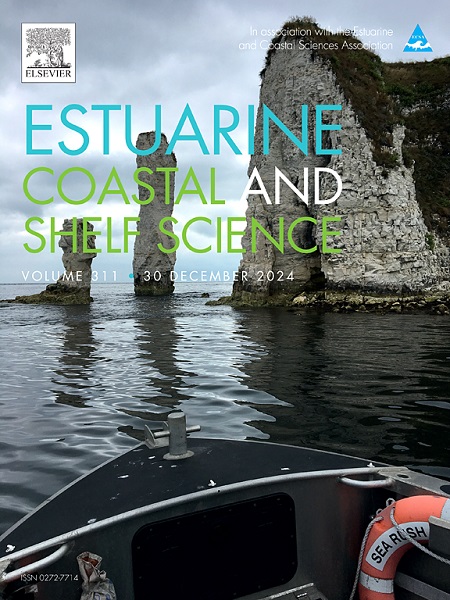Spatial distribution of mangrove soil organic carbon in Indus Delta, Pakistan: A multi-sensor remote sensing and machine learning approach
IF 2.6
3区 地球科学
Q1 MARINE & FRESHWATER BIOLOGY
引用次数: 0
Abstract
Mangrove forests play a crucial role in carbon sequestration, especially in the coastal zones of arid regions where their ability to store carbon in soil is generally much higher than in terrestrial drylands. The Indus Delta in Pakistan is the world's largest arid mangrove forest system but lacks spatially explicit data on Soil Organic Carbon (SOC) despite its importance for conservation and carbon budgeting. This study aims to establish a baseline SOC map for 2020 at 10 m spatial resolution using Sentinel-1 (Synthetic Aperture Radar) and Sentinel-2 (MultiSpectral Instrument) satellite imagery, integrated with in-situ soil sampling. SOC predictions were made using a Classification and Regression Tree (CART) machine learning model within the Google Earth Engine platform, leveraging 40 predictor variables, including spectral bands and derived indices. A total of 53 topsoil (10 cm depth) samples were collected in February 2020 across the Indus Delta, and SOC was analyzed using the Walkley-Black method. The results showed an average SOC value of 67.59 ± 37.41 MgC ha−1 (to 10 cm depth), and local values ranging from 15.07 to 138.04 MgC ha−1. with a total of 0.91 PgC. The CART model demonstrated high accuracy, with an R2 of 0.95 and an RMSE of 9.18 MgC ha−1. However, the region faces challenges such as seawater intrusion and hypersalinity, which threaten its ability to sequester carbon. With the first high-resolution SOC map for the Indus Delta, this study provides valuable insights for ecosystem management, conservation planning, and carbon budgeting. These findings of this study have the potential to significantly influence initiatives like REDD+ and Blue Carbon projects, which aim to enhance carbon sequestration while addressing the ecological challenges facing Pakistan's mangroves.
巴基斯坦印度河三角洲红树林土壤有机碳空间分布:多传感器遥感和机器学习方法
红树林在固碳方面发挥着至关重要的作用,特别是在干旱地区的沿海地区,它们在土壤中储存碳的能力通常比陆地旱地高得多。巴基斯坦的印度河三角洲是世界上最大的干旱红树林系统,但缺乏土壤有机碳(SOC)的空间明确数据,尽管它对保护和碳预算很重要。本研究旨在利用Sentinel-1(合成孔径雷达)和Sentinel-2(多光谱仪器)卫星图像,结合原位土壤采样,建立2020年10米空间分辨率的基线SOC地图。利用谷歌Earth Engine平台中的分类与回归树(CART)机器学习模型,利用40个预测变量(包括光谱带和衍生指数)进行SOC预测。2020年2月,在印度河三角洲共收集了53个表层土壤(10 cm深度)样本,并使用Walkley-Black方法对土壤有机碳进行了分析。结果表明,在10 cm深度处,土壤有机碳平均为67.59±37.41 MgC ha−1,局部为15.07 ~ 138.04 MgC ha−1。总PgC为0.91。CART模型具有较高的准确度,R2为0.95,RMSE为9.18 MgC ha−1。然而,该地区面临着海水入侵和高盐度等挑战,这些挑战威胁到其固碳能力。该研究首次获得了印度河三角洲的高分辨率有机碳地图,为生态系统管理、保护规划和碳预算提供了宝贵的见解。这项研究的这些发现有可能对REDD+和蓝碳项目等倡议产生重大影响,这些项目旨在加强碳固存,同时解决巴基斯坦红树林面临的生态挑战。
本文章由计算机程序翻译,如有差异,请以英文原文为准。
求助全文
约1分钟内获得全文
求助全文
来源期刊
CiteScore
5.60
自引率
7.10%
发文量
374
审稿时长
9 months
期刊介绍:
Estuarine, Coastal and Shelf Science is an international multidisciplinary journal devoted to the analysis of saline water phenomena ranging from the outer edge of the continental shelf to the upper limits of the tidal zone. The journal provides a unique forum, unifying the multidisciplinary approaches to the study of the oceanography of estuaries, coastal zones, and continental shelf seas. It features original research papers, review papers and short communications treating such disciplines as zoology, botany, geology, sedimentology, physical oceanography.

 求助内容:
求助内容: 应助结果提醒方式:
应助结果提醒方式:


